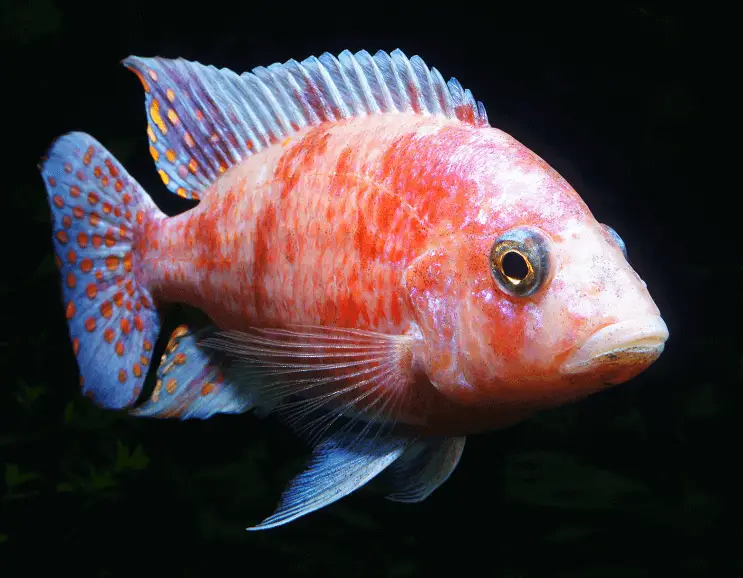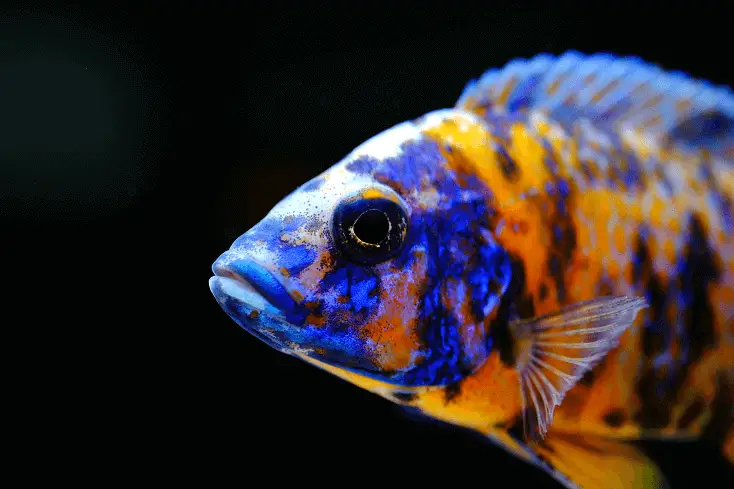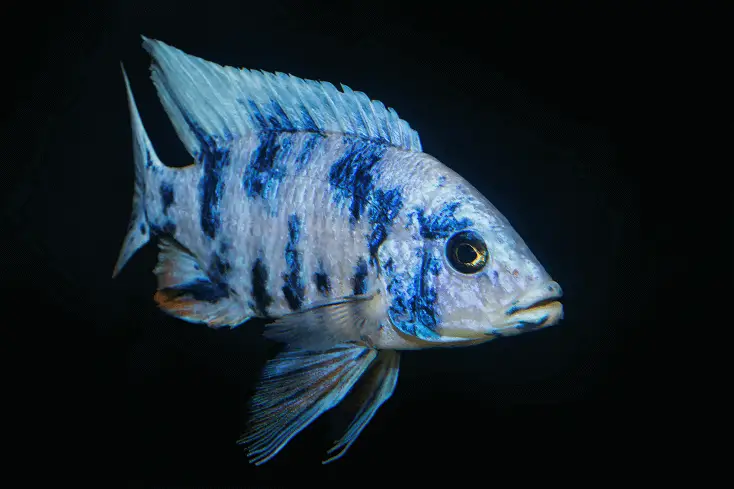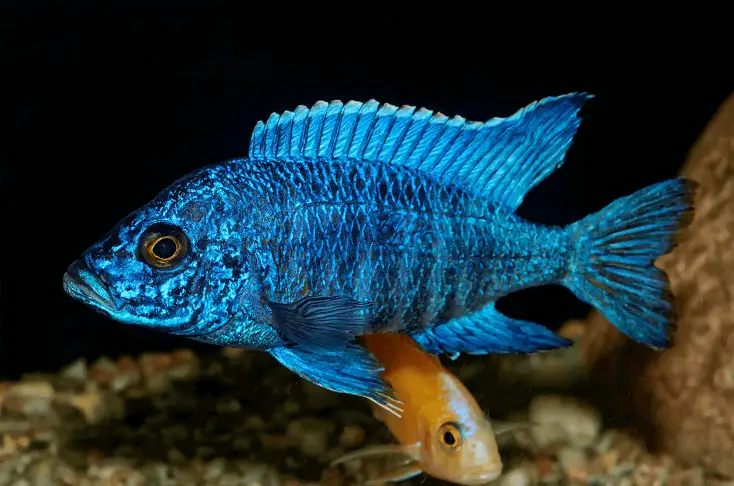Peacock Cichlid Care Guide & Species Profile
The peacock cichlid is a freshwater fish of the cichlid family unit and one of the African cichlids. Peacock cichlids are friendly, agile fish that come up in vivid colours of regal, yellowish, red, and orange.
At that place are more than 20 peacock cichlid color variations. The two common types of peacock cichlid are the red peacock cichlid and the bluish peacock cichlid.
Peacock cichlids are popular amid aquarists considering of their cute colors and their ease of intendance, although in cramped tank environments, the fish have an aggressive streak.
Peacock Cichlid Facts & Overview

Advertisements
| Scientific proper noun: | Aulonocara |
| Common names: | Peacock cichlid, aulonocara, peacock |
| Distribution: | Lake Malawi in East Africa |
| Size: | iv–6 inches |
| Life expectancy: | vi–8 years |
| Color: | Vibrant purple, yellowish, orange, carmine, blue, pinkish |
| Diet: | Omnivore |
| Temperament: | Semi-aggressive |
| Minimum tank size: | 55 gallons |
| Temperature: | 76–82°F (24–28°C) |
| pH: | 7.eight–eight.half dozen |
| Hardness: | 4–6 dGH |
| Care level: | Easy |
| Breeding: | Oral cavity brooder |
Origin
All colour variations of the peacock cichlid are found in Lake Republic of malaŵi. The fish swim at the bottom of the lake, searching for food in the sandy substrate.
In the wild, peacock cichlids are active, skillful swimmers, and are commonly institute in the shallows and shores of their habitat.
Lake Malawi has a sandy, rocky substrate, with clear waters, and freshwater plants like eelgrass. The lake is densely populated with a diversity of colorful fish.
Advertisements
Adult Size & Lifespan
Fully-grown peacock cichlids reach up to 6 inches long. Male person peacock cichlids grow up to i inch longer than females, and females have rounder bellies than males.
When properly cared for, peacock cichlids live for between half-dozen and viii years in captivity. Some peacock cichlids live beyond 10 years.
Availability
Peacock cichlids are widely bachelor in fish stores and online, and most stores sell several color variations of this cichlid.
The boilerplate price of a peacock cichlid is $6–$twenty per fish. Males are more expensive than females because males have brighter, bolder colors compared to females. You tin can buy peacock cichlids in most reputable online stores:
- LiveAquaria sells blue peacock cichlids, albino peacock cichlids, and yellowish peacock cichlids.
- Imperial Tropicals sells dragon blood (carmine) peacock cichlids, albino dragon blood peacock cichlids, and all-male person and unsexed peacock cichlid packages.
Appearance & Beliefs

Peacock cichlids are vibrant, colorful fish with long, torpedo-shaped bodies. Although peacock cichlids are usually peaceful, the fish have aggressive territorial tendencies.
Colors, Patterns, Fins, and Sexual practice Differences
Peacock cichlids are pocket-sized fish with bold, bright, irised coloring. Some peacock cichlid color variations are found naturally in the wild, and other species have been created by selective breeding in captivity. The virtually popular variations are:
- Sunshine peacock cichlids: otherwise known every bit yellow peacock cichlids, take golden yellowish bodies and blue heads.
- Butterfly peacock cichlids: have orangish and purple striped bodies and purple heads.
- OB peacock cichlids: take red bodies with night blue patches that are brightest on the fish's face.
- Strawberry peacock cichlids: which are reddish-pink with strawberry-like dots on their bodies.
- Ruby peacock cichlids: accept red bodies with white speckles.
- Blueish peacock cichlids: which have deep blue bodies, sometimes patterned with orange.
- Albino peacock cichlids: which have white or orange bodies and bright crimson optics.
All color variations of peacock cichlids have the same body shapes and the same sleek, streamlined fins and tails.
Male peacock cichlids have brighter colors than females, peculiarly when trying to impress females during mating. Females have paler bellies than males. Juvenile peacock cichlids become brighter as they grow into adult fish.
When stressed, peacock cichlids become duller than usual.
Typical Behavior
Peacock cichlids are sociable, active fish that are compatible with nigh other freshwater aquarium fish. Cramped tank conditions and too many males versus females can cause peacock cichlids to exhibit ambitious territorial behaviors similar chasing, nipping, and fighting.
Peacock cichlids are fast swimmers and require plenty of open space in the bottom and mid-sections of the tank. They're too diurnal, meaning that they're active during the twenty-four hours and rest during the nighttime. Peacock cichlids eat and sleep at the bottom of the tank nearly the substrate.
Advertisements
Peacock Cichlid Care & Tank Requirements

Caring for peacock cichlids is easy. The fish crave a tropical freshwater tank that closely resembles their natural habitat and an omnivorous nutrition of meat and institute matter.
Habitat and Tank Requirements
Peacock cichlids are adjusted to thrive in the tropical waters of Lake Malawi, with a sandy, rocky substrate and a stable pH. Your tank should replicate Lake Malawi's ecosystem as closely equally possible to provide the optimal atmospheric condition that peacock cichlids demand to stay healthy.
The minimum tank size for peacock cichlids is 55 gallons, or 100 gallons for a community of 4 to vi peacock cichlids. Peacock cichlids are active swimmers that will use all the tank space you provide. The tank should have more than horizontal than vertical space.
Advertisements
A sandy substrate is all-time for peacock cichlids. Don't use a rough or precipitous substrate because this could injure the fish when they sift through it in search of food. Position big rocks, caves, and hollow decorations to provide hiding places for peacock cichlids, and to reduce territorial behavior.
Use hardy, deep-rooted plants such every bit anacharis and Java fern, which tin can't be uprooted past peacock cichlids.
Tank Conditions
The ideal tank weather condition for peacock cichlids are:
| Water type: | Difficult alkaline freshwater |
| Tank size: | Minimum 55 gallons, or 100 gallons for a group of fish |
| H2o temperature: | 76–72°F |
| Substrate: | Sand or soft gravel |
| Tank setup: | Plants, caves, hollow decorations |
| Acidity: | vii.7–8.4 pH |
| H2o hardness: | 4–6 dGH |
| Filter: | Yes. Peacock cichlids require large tanks and produce a lot of waste, so a potent filter is essential for cleaning the tank |
| Bubbler: | Not essential for peacock cichlids |
| Lighting: | Yes, to stimulate lighting and encourage constitute growth |
| Water heater: | Yes, to ensure water is warm plenty for the fish |
Peacock cichlids are hardy fish that tin can tolerate water fluctuations, but maintaining consistent h2o parameters will greatly reduce the fish'south risk of disease, and will encourage a harmonious tank environment. Employ a thermometer and pH reader to regularly monitor your h2o parameters, and make adjustments if necessary.
Disease
There are several common freshwater diseases that affect peacock cichlids in captivity:
Republic of malaŵi Bloat
Malawi bloat, or dropsy, is acquired by liver dysfunction or poor diet. Fish with Malawi bloat have swollen bellies, stake feces, no appetite, and labored animate. Astringent cases of Republic of malaŵi bloat can cause rapid death.
Treat Malawi bloat by changing 25% of the water in the tank every two days until the fish gets better. Use handling recommended by your veterinarian if the fish's symptoms don't clear within a week.
Swim Float Affliction
Swim bladder illness is acquired past parasites that infect the swim float, or past excess intestinal gas. Fish with swim float affliction take problems swimming and float at the top of the tank.
Prevent swim bladder disease past making certain not to feed your fish a diet too rich in poly peptide. Treat mild cases of swim bladder disease by feeding the affected fish a nutrition of green peas. Serious cases of the illness may require surgery.
Mycobacteriosis
Mycobacteriosis, known as fish tuberculosis, is a highly communicable diseases caused by rod-shaped mycobacteria. Symptoms of fish mycobacteriosis include lack of appetite, a sunken abdomen, frayed fins, and white speckles on the fish's body.
Quarantine the affected fish to forbid the disease from spreading, and care for the quarantine tank's water with antibody treatment. Disinfect the home tank to eliminate the disease.
Tank Mates

Peacock cichlids can peacefully share a tank with fish species that thrive in the same water conditions, such as other fish from Lake Malawi.
The most uniform fish species are peaceful, friendly fish that occupy the tiptop sections of the tank. Don't firm peacock cichlids with ambitious fish species like betta fish, tiger barbs, and nigh other cichlid species.
Swell tank mates for peacock cichlids include:
- Other peacock cichlids (one male to every two females to prevent dominant behavior)
- Plecos
- Rainbow sharks
- Reddish tail sharks
- Red center tetras
- Synodontis catfish
Diet and Feeding
In the wild, peacock cichlids eat whatsoever they can find in the substrate, including zooplankton, insects, larvae, algae, crustaceans, and constitute matter.
Feed the same varied diet to peacock cichlids in captivity. Provide a combination of loftier quality fish food flakes, live or frozen brine shrimp, algae wafers, and vegetables like fair-skinned spinach and lettuce.
Feed a pinch of nutrient to peacock cichlids two or three times per day, ensuring enough food is bachelor for 2 minutes of eating. Remove uneaten nutrient to avoid disturbing the water chemical science.
Advertisements
Don't feed mammal meat or tubifex worms to peacock cichlids considering these foods cause Malawi bloat. To forestall peacock cichlids from losing their coloring and getting sick, accept intendance non to overfeed the fish.
Convenance
Breeding peacock cichlids is a straightforward process. Peacock cichlids are oral fissure brooders that reach sexual maturity at ix months erstwhile.
To breed peacock cichlids, follow these instructions:
- Set up a separate breeding tank with a water temperature of 82°F, a sandy substrate, and several caves for breeding.
- Select one healthy male and up to four healthy females and move the fish to the breeding tank.
- The male will plant his breeding territory, choosing a cave to inhabit.
- The male volition perform a 'dance,' darting from side to side, to get the females' attention.
- When an interested female joins the male, the pair will breed inside the cave and the female will lay eggs in a nest. Return the other females to the home tank.
- After the male person fertilizes the nest, the female person will collect the eggs in her mouth.
- The female will stay inside the cavern for up to 28 days until the eggs hatch.
- Between 12 and 15 fry will hatch. Remove the parents to forestall them from eating their babies.
- Feed the fry brine shrimp or infusoria. Once the offspring accomplish 2 inches or longer, the fish can be moved into the master tank.
Should Y'all Get a Peacock Cichlid for Your Aquarium?
Every bit one of the most peaceful cichlid species, peacock cichlids are suitable for both new and experienced fishkeepers.
You should become a peacock cichlid if your aquarium has plenty of room for creating unlike territories. Don't get a peacock cichlid if your tank is already crowded or contains unfriendly, aggressive fish.
Peacock cichlids are beautiful, vibrant fish that add a pop of color to a community aquarium.
Source: https://www.fishkeepingworld.com/peacock-cichlid/

0 Response to "Peacock Cichlid Care Guide & Species Profile"
Post a Comment